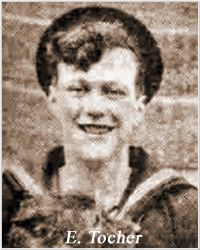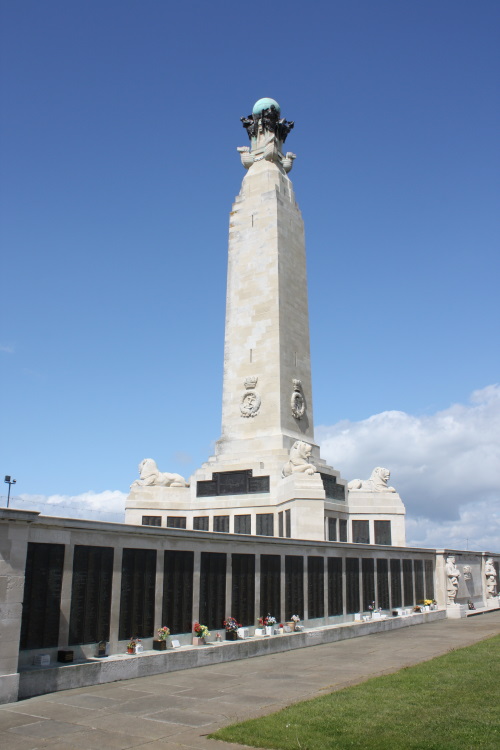-H.M.S. Hood Crew Information-
H.M.S. Hood Rolls of Honour
Memorials to Men Lost in the sinking

In Remembrance of
Edwin Tocher

Place of birth: Bucksburn, Aberdeen, Aberdeenshire, Scotland
Parents: Grandson of Edward and Barbara Tocher
Service: Royal Navy
Rank: Ordinary Seaman
Service Number: P/JX 158987
Joined Hood: 7th September 1940
Left Hood: 24th May 1941 (loss of ship) (Ordinary Seaman)
Click here to print memorial poster
Biographical Information:
Edwin was born on 19th December 1921 to Edward and Barbara Tocher, of 202 Auchmill Road, Bucksburn, Aberdeenshire, Scotland. He was employed as a cinema page boy prior to joining the Navy on 21st June 1939.
Edwin was initially trained at H.M.S. Caledonia and joined H.M.S. St. George on 5th September 1939. He was posted to H.M.S. Afridi (through H.M.S. Cochrane 2) on 23rd November 1939. He was promoted to Ordinary Seaman on 19th Decemeber of that same year.
He is known to have served as a gunner aboard the destroyer H.M.S. Afridi. He helped fellow crewmen survive its sinking after being bombed off Narvik, Norway in May 1940. This was reported by the Aberdeen Weekly Journal on 23 May 1940:
Aberdeen Navyman's Story of Bravery on Afridi
With waves of German bombers sweeping overhead, survivors of the warship Afridi played water polo with a piece of cork lifebelt while waiting to be picked up by other destroyers which rescued them.
Among them was eighteen-year-old seaman Edwin Tocher, whose home is at 202 Auchmill Road, Bucksburn, Aberdeen. His story, told to the "Weekly Journal" representative, revealed acts of supreme coolness and courage when the Afridi was sunk by a bomb while assisting in the withdrawal of troops from Namsos.
Seaman Tocher helped to work the only gun left in action just before the warship sank.
Dived on Troopships
The gun crew stayed long enough to bring down three Nazi bombers after the warship had been struck. Then as she heeled over, they dived overboard and swam to safety under a sheet of blazing oil which covered the water around her.
"We were in the convoy when we were struck," said seaman Tocher. "The Nazis had been coming over in squadrons before that but the attack which got us was carried out by three dive bombers. First of all they dived on the troopships. Then when we got between them and the troopships and sent up a barrage they turned their attention to us. Two bombs missed us the third a 1000 lb. missile, struck the Afridi I was at the pom-poms aft and was flung off my feet by the force of the explosion.
Time to Get Out
"One of the magazines went off. Those of us who were saved owe our lives to the coolness of Captain Vian. He gave orders for the other magazines to be flooded. Ours was the only gun left in action. We brought down one bomber just as we were struck and we kept blasting away and managed to bring down two others. Meanwhile the Afridi was gradually healing over to port. Then the stern began to rise before she took the final plunge, and we thought it was time to get out. By this time oil from the fuel tanks had spread over the water and patches of it were blazing. Fortunately, I am a good swimmer, and I knew I could swim clear of it under water. I discarded my life-belt and swam under the water wearing only a pair of trousers and a German jacket I had picked-up when we were ashore at Namsos."
Machine-Gunned in Water
"Other warships came on the scene, they began to pick up wounded men and non-swimmers first. I was unhurt apart from having my feet slightly burned, and it was about an hour and twenty minutes before I was picked up. While we were waiting some of the boys started a game of water polo with a piece of cork from a lifebelt. I had a turn at the game myself."
Seaman Tocher said it was impossible to launch and boats from the Afridi, Captain Vian escaped like the others by diving overboard. Helping in rescue work were a boat load of men from another British warship. Their boat was overturned by a bomb bursting near them and the men were machine-gunned in the water before the survivors were picked up.
He said Afridi was the first vessel to land troops at Namsos and the first to take them off. It was found that the Germans had bombed the quay so fiercely that the damage made it impossible to get a large troopship alongside. The Afridi however, took soldiers aboard and landed them by nosing her bows alongside. She also carried soldiers on the withdrawal.
The Namsos adventure was the climax of weeks of exciting times in which seaman Tocher share dodging in and out of fjords with bombers attacking them every day. It began with the second battle of Narvik, in which however, the Afridi crew were little more than lookers-on.
"We went in after the Warspite and the others" he said "The situation had been pretty well cleared up before we got in however, and we fired only a few shots. Visibility was very bad and we could not see what was going on ahead of us - but we could hear it all right."
Seaman Tocher returned on leave with his eyes still red-rimmed with want of sleep, after days and nights on end at battle stations. But he is looking forward to returning to duty on Monday..."
Following the loss of Afridi, Edwin was assigned to H.M.S. Victory on 4th May 1940. He was briefly assigned to the French torpedo boat La Melpomene that summer as well. He was reassigned to Hood on 7th September 1940.
He was 19 years old at the time of his loss. He was posthumously awarded the 1939-45 Star, Atlantic Star and War Medal.
Additional Photographs
None at this time.
Hood Chapel, Church of St. John the Baptist, Boldre, Hampshire, England
Photos of the memorial
Portsmouth Naval Memorial, Southsea, Hampshire, England
Photos of the memorial

The part of the memorial in which the Hood casualty names can be found.
(Panels 45 to 61)

Edwin's name is in Column 2 of Panel 51.
Detail of Edwin's name.
Sources
Commonwealth War Graves Commission
'Register of Deaths of Naval Ratings' (data extracted by Director of Naval Personnel (Disclosure Cell), Navy Command HQ, 2009)
John Scott (photo & information, May 2018)
Mary Mckeown (photo & information derived from the "Abderdeen Journal", September 2013)